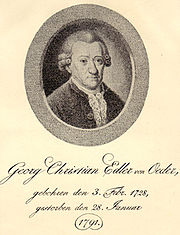Georg Christian Oeder


Georg Christian Edler von Oldenburg Oeder(3 February 1728 – 28 January 1791) was aGerman-Danishbotanist,medical doctor,economistand social reformer. His name is particularly associated with the initiation of the plate workFlora Danica.
Life and work
[edit]Oeder was born inAnsbachto aBavarianparish minister and theologian,Georg Ludwig Oeder(1694–1760). He studiedmedicineat theUniversity of GöttingenunderAlbrecht von Haller.He then settled as a doctor of medicine in the city ofSchleswig.Thekingcalled him toCopenhagenin 1751, onvon Haller'srecommendation. The autonomous – and conservative -University of Copenhagen,reluctant as it was to employ foreign experts, resisted Oeder's appointment in an ordinary chair. Thus, he was appointedProfessor botanices regius(Royal Professor) and soon led the installation of a newbotanic garden.From 1753 he led the publication of a monumental botanical plate work,Flora Danica,which at first was planned to cover all plants, includingbryophytes,lichensandfunginative to crown lands of theDanishking – Denmark,Schleswig-Holstein,Oldenburg-DelmenhorstandNorway– with itsNorth AtlanticdependenciesIceland,theFaroe IslandsandGreenland.[1][2]Oeder visited the mountain regions of Norway up toTrondheimduring the years 1758–1760. Consequently, the first fascicles ofFlora Danicacontain manyalpine plantspecies. Oeder also corresponded with the Norwegian bishop and botanistJohan Ernst Gunnerusduring the time. Oeder also built up a considerable botanical library, mainly through purchase from colleagues abroad. English and American literature was obtained fromPhilip MillerofChelsea Physic Gardenand as many as 1327 volumes were bought from the estate ofRichard Meadin 1754.[3]
At the time of Oeder,botanywas amalgamated witheconomyat large. Oeder thus was also a member of a number of commissions onagrarian reforms(e.g. “Landkommissionen” in 1770) and state finances ('Finanskollegiet' in 1771). From the first Danishcensus,which was soon destroyed, he extracted data on married couples,widowersand widows in all parishes ofZealand,Amager,MønandBornholm– these excerpts are now valuable data togenealogists.[4]Oeder advocated the need for charities for widows.[5]At large, Oeder was a spokesman of social reform and freedom of the rural population.[6][7]
With the fall ofJohann Friedrich Struenseein 1771 and the consequent crisis in state finances and the strengthening of anti-enlightenmentand anti-German conservative circles, Oeder lost his professorship. He was first given the post asprefect(stiftamtmand) ofTrondhjem stift,but never installed. He then was given a little honorable post as bailiff (Landvogt) inOldenburg,which was then under Danish rule, but to be exchanged toHolstein-Gottorpin 1773. Two years before his death, he was ennobled by emperorJoseph II.He died inOldenburgand was buried in the churchyard of St. Gertrude's Chapel (Gertrudenfriedhof).
Plant taxa named for Oeder
[edit]The plant genusOederaL.was named to his honour. A number of species have been named similarly, e.g.Pedicularis oederiVahlandCarex oederiRetz.
Footnotes
[edit]- ^Oeder, Georg Christian (1761)Efterretning om et Verk, som paa Kongelig Befaling skal udgives, FLORA DANICA kaldet, tilligemed en Prøve-Plade af Multebærs Planten (Rubus Chamæmorus)Archived2008-10-21 at theWayback Machine.Kopenhagen.
- ^Oeder, Georg ChristianVerzeichniss zur der Flora Danica gehörigen, in den Königreichen Dännemark und Norwegen, in den Herzogthümern Schleswig und Holstein, und in den Grafschaften Oldenburg und Delmenhorst wildwachsenden Kräuter.Kopenhagen, 1770. 137 pp.
- ^Wagner, Peter & Birgit Stauning (2001) Botanisk Centralbibliotek, p. 78-81 in: Bernhard Fabian, Handbuch deutscher historischer Buchbestände in Europa. Georg Olms VerlagISBN3-487-10360-5Google Books
- ^""Oeders Efterretninger" 1771 in the Danish Demographic Database ".Archived fromthe originalon 2008-06-18.Retrieved2008-07-14.
- ^Oeder, G. C. (1771)Raisonnemens über Wittwen-Cassen.Kopenhagen, 84 pp.
- ^Oeder, G. C. (1769)Bedenken über die Frage: Wie dem Bauernstande Freyheit und Eigenthum in den Ländern, wo ihm beydes fehlet, verschaffet werden könne?Frankfurt & Leipzig, 112 pp. Additions:Zusäze zu dem Bedenken über die Frage: Wie dem Bauernstande etc.Frankfurt & Leipzig (1771) andBedenken und Zusätze; von neuem aufgelegt sammt Zulagen.Altona (1786)
- ^Oeder, G. C. (1781)Antwort aufJ. C. FabriciusZudringlichkeit in seiner Schrift über die Volks-Vermehrung in Dännemark.Oldenburg,20 pp.
- ^International Plant Names Index.Oeder.
References
[edit]- Anker, Jean (1951)Georg Christian Oeder's botanical trip in Europe in the middle of the 18th century.Centaurus 1 (3): 242-265PMID14859290
- Anker, Jean (1952)Georg Christian Oeder and the work on a new medical code of regulations during the regime ofStruensee.Acta Med Scand Suppl. 1952; No. 266: 21-27PMID14902350
- Wagner, Peter (1993)G.C. Oeders beretning om en lærd rejse tilBornholm1763.Danske Magazin Rk. 8, bd. 6, hft. 3: 300–315.
External links
[edit]- 1728 births
- 1791 deaths
- 18th-century Danish botanists
- Edlers of Germany
- 18th-century German botanists
- Academic staff of the University of Copenhagen
- University of Göttingen alumni
- German social reformers
- Emigrants from the Holy Roman Empire to Denmark–Norway
- Botanists from the Holy Roman Empire
- Scientists from Denmark–Norway
